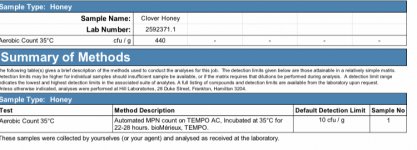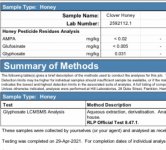Wouldn't that mean that the bees would collect it once sprayed and recycle it for yet another crop?possibly a market there for Manuka flavoured weed killer.. many other products benefit from having Manuka added.. why not a weed killer?
Time to ban glyphosate?
- Thread starter bighands
- Start date
You are using an out of date browser. It may not display this or other websites correctly.
You should upgrade or use an alternative browser.
You should upgrade or use an alternative browser.
Welcome to NZ Beekeepers+
Would you like to join the rest of our members? Feel free to sign up today.
Sign up
Sorry @Sailabee just to be clear the above comment wasn’t serious was more of a laugh at the number of products out there claiming Manuka as ingredient..Wouldn't that mean that the bees would collect it once sprayed and recycle it for yet another crop?
Last results in today this site is next to a large forestry block recently harvested, the chopper has sprayed the block prior to re planting. There is no pastureland in range of these bees.
View attachment 165
how far from your hives were they spraying ?
the forestry have just given notice of a pre plant spray program and we are wondering how far away is safe ?
Inside 1 km.. at a guess 800m from site to edge of spray zone.. the area sprayed was pretty big and covered in thistle which the bees must have been working.. chopper worked well into the day no doubt flying bees were soaked also.
forest company claimed they didn’t know hives were there.. been a bee site for many many years and with my paint scheme pretty hard to miss..
I’ve had a spray plan sent today as well.. at least the communication line is open now following my visit to the office.
forest company claimed they didn’t know hives were there.. been a bee site for many many years and with my paint scheme pretty hard to miss..
I’ve had a spray plan sent today as well.. at least the communication line is open now following my visit to the office.
Not a glyphosate result, shows your cfu test result.Can someone decipher this glyphosate test result....?
speaking of glyphosate, press release here worth a read?
 www.epa.govt.nz
www.epa.govt.nz
EPA calls for information on glyphosate | EPA
EPA call for information on glyphosate
New results
Easy - your sample has glyphosate in it. It does not have the metabolite, AMPA, or the somewhat commonly used alternative, glufosinate.
Does this mean the AMPA & glufosinate results shown are lower than the technology is capable of detecting and are just some stray pixels floating around ? Or are you saying for practical purposes they aren't there ?Easy - your sample has glyphosate in it. It does not have the metabolite, AMPA, or the somewhat commonly used alternative, glufosinate.
The technology can go further but there is no practical purpose. The levels are only trace. However the Glyphosate needs to be <0.01 jar JapanDoes this mean the AMPA & glufosinate results shown are lower than the technology is capable of detecting and are just some stray pixels floating around ? Or are you saying for practical purposes they aren't there ?
To me it says you won’t be sending that honey to Japan.New results
Does this mean the AMPA & glufosinate results shown are lower than the technology is capable of detecting and are just some stray pixels floating around ? Or are you saying for practical purposes they aren't there ?
It essentially means that the lab is confident there is not more than 0.02 mg/kg of AMPA, or 0.005 mg/kg of glufosinate. It doesn't mean there is none there, but it does mean that if it is there, it's almost certainly lower than those figures. Any further interpretation would just be speculation on my part, since those results aren't from my lab and I'm not intimately familiar with their particular analysis method.
The technology can go further but there is no practical purpose. The levels are only trace. However the Glyphosate needs to be <0.01 jar Japan
Exactly correct. Going lower would certainly be possible, but it would require a lot of development work, and it would be a more expensive test to boot.
The technology can go further but there is no practical purpose. The levels are only trace. However the Glyphosate needs to be <0.01 jar Japan
I was questioning @Jacob's use of the phrase "It does not have " when to me plainly it does !!It essentially means that the lab is confident there is not more than 0.02 mg/kg of AMPA, or 0.005 mg/kg of glufosinate. It doesn't mean there is none there, but it does mean that if it is there, it's almost certainly lower than those figures. Any further interpretation would just be speculation on my part, since those results aren't from my lab and I'm not intimately familiar with their particular analysis method.
Exactly correct. Going lower would certainly be possible, but it would require a lot of development work, and it would be a more expensive test to boot.
It's a bit of a kick in the guts eh .To me it says you won’t be sending that honey to Japan.
100% pure New Zealnd and our honey is banned from a major ish trading partner .....maybe the Japanese are trying to grow their peasant economy, just like New Zealand Gvt had Manuka as a growth industry projected to generate a billion dollars worth of exports ..... after all Bees are great little earner in an urban environment, and Japan has lotsa that, apparantly.
The kick in the guts is that we here up beyond the Black Stump use very few chemicals. Roundup is banned on the farm. Gorse is mulched ....unless it's too steep when we have to resort to Tordon, but we make sure all the bees are gone before the chopper comes in ...
Which I guess just proves that you can be as Fastidious and Belligerent as you want .....but if yer neighbours neighbour is still in the dark ages, you're F'd.
Blend 'n' SendLooks like the japs wont be eating honey in the near future....eh
@DonMac have you thought to ask those companies doing the tests for summaries - perhaps by area with the beekeepers details witheld? This would at least give macro figures to start with.In Europe there is much more information on how much of each agrichemical is used and on what crop it is used. The Netherlands has even more detailed information. In NZ we have none of that data collection. For the EPA reassessment of neonicotinoids the EPA had to ask the Ag Chem industry to provide information on the amount used and what crops it is used on - we are waiting for the EPA to make this public.
I am surprised no one is offering their glyphosate lab test data results to date. If we have access to this data in a sufficient sample size we can use our bees foraging efforts to survey glyphosate use throughout the country. This would be helpful in discussions with MPI.
We’ll send more samples away next week....
Honey Dew from the foothills
And a west coast brew...
Honey Dew from the foothills
And a west coast brew...



